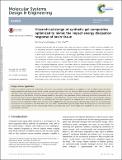| dc.contributor.author | Qing, Bo | |
| dc.contributor.author | Van Vliet, Krystyn J | |
| dc.date.accessioned | 2021-01-28T02:26:26Z | |
| dc.date.available | 2021-01-28T02:26:26Z | |
| dc.date.issued | 2016-08 | |
| dc.date.submitted | 2016-06 | |
| dc.identifier.issn | 2058-9689 | |
| dc.identifier.uri | https://hdl.handle.net/1721.1/129593 | |
| dc.description.abstract | Synthetic polymer gels that accurately mimic key mechanical properties of brain tissue are valuable tools for evaluating protective equipment and understanding injury mechanisms, for example in response to concentrated mechanical impact events. Here, we employ impact indentation to investigate the response of brain tissue from three species (mice, rats, and pigs), quantified in terms of penetration resistance, energy dissipation capacity, and energy dissipation rate. We identify measurable variations in these three metrics among the different animal models, suggesting that a highly tunable materials system is required to capture the full impact response of specific brain models. To achieve enhanced tunability of energy dissipation, we engineer bilayered polymer composites based on polydimethylsiloxane (PDMS) elastomers and swollen organogels. This bilayer design leverages the key properties of each individual layer to decouple the penetration resistance and energy dissipation characteristics of the composite material. Additionally, we demonstrate that by sequentially tuning the stiffness and thickness of the top layer, all three of these impact response metrics can be optimized to match that of porcine brain tissue. Together, these results suggest that the mechanical behavior of composite gels under impact loading can be modulated to mimic different brain tissues and brain injury models with high fidelity. ©2018 The Royal Society of Chemistry. | en_US |
| dc.description.sponsorship | U.S. Army through the Institute for Soldier Nanotechnologies (W911NF-07-D-0004) | en_US |
| dc.language.iso | en | |
| dc.publisher | Royal Society of Chemistry (RSC) | en_US |
| dc.relation.isversionof | https://dx.doi.org/10.1039/C6ME00051G | en_US |
| dc.rights | Creative Commons Attribution-Noncommercial-Share Alike | en_US |
| dc.rights.uri | http://creativecommons.org/licenses/by-nc-sa/4.0/ | en_US |
| dc.source | Other repository | en_US |
| dc.title | Hierarchical design of synthetic gel composites optimized to mimic the impact energy dissipation response of brain tissue | en_US |
| dc.type | Article | en_US |
| dc.identifier.citation | Qing, Bo and Krystyn J. Van Vliet, "Hierarchical design of synthetic gel composites optimized to mimic the impact energy dissipation response of brain tissue ." Molecular Systems Design & Engineering 1, 3 (October 2016): 290-300 ©2016 Authors | en_US |
| dc.contributor.department | Massachusetts Institute of Technology. Department of Biological Engineering | en_US |
| dc.contributor.department | Massachusetts Institute of Technology. Department of Materials Science and Engineering | en_US |
| dc.relation.journal | Molecular Systems Design & Engineering | en_US |
| dc.eprint.version | Author's final manuscript | en_US |
| dc.type.uri | http://purl.org/eprint/type/JournalArticle | en_US |
| eprint.status | http://purl.org/eprint/status/PeerReviewed | en_US |
| dc.date.updated | 2019-09-24T17:44:30Z | |
| dspace.date.submission | 2019-09-24T17:44:34Z | |
| mit.journal.volume | 1 | en_US |
| mit.journal.issue | 3 | en_US |
| mit.metadata.status | Complete | |
